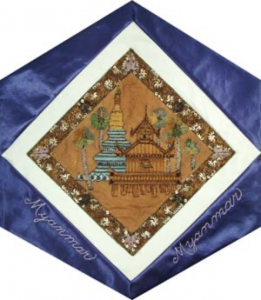Myanmar

The Block
Myanmar is known for its silk-weaving, a wonderful example of which was used as the main subject of this block. The piece, embellished with embroidery, was made and donated by U Kan Thein and Gerry Hainesrtm, who based their design on the magnificent stupas (pagoda-like religious monuments) found throughout Myanmar. The grandest stupa is the Shwe Dagon Pagoda, a cone-shaped, 326-foot high Buddhist temple that is completely covered with gold and surrounded by 72 shrines. The unique architecture of this structure and a monastery have been skillfully re-created in rich, silk-thread embroidery and surrounded by an intricately stitched border decorated with small, metal rings.
Cultural Profile
Myanmar (formerly known as Burma), one of East Asia’s largest nations, is located between Bangladesh and Thailand along the Bay of Bengal and the Andaman Sea. A land of breathtaking beauty and charm that has only recently emerged into the modern world, Myanmar is divided into five distinct geographical regions. These areas include the northern Kumon Mountains (part of the Himalayas) whose majestic peaks rise out of the landscape.
Teak is a major export industry and Myanmar is home to three-quarters of the world’s teak timber reserves. This type of wood has long been a favourite of shipbuilders because of its strength, flexibility and resistance to rot. Many precious and semi-precious gemstones can also be found here; in 1982 the largest piece of jade in the world, weighing in at 33 tons, was discovered in Kachin State.
Myanmar is a union of 135 ethnic groups, each with their own languages and dialects, although Burmese is the most commonly spoken tongue. The major groups are the Bamar, Kachin, Kayah, Kayin, Chin, Mon, Rakhine and Shan.
The majority of people in Myanmar, which is sometimes called the “land of rice and rivers,” are involved in agriculture. Crops include rice, mangoes, melons, beans, tomatoes and chili peppers. The culture is very much influenced by neighboring China, India and Thailand. For celebrations and festivals, people dress in eingyi (shirts) and ankle-length wrap-around skirts called longyis that are made of beautifully woven silks or cottons. The silver bracelets and ornamental jewelry worn as accessories by women are valuable investments. Padaung women are known for the numerous thick, bronze neck-rings they wear in the belief that beauty lies in a long neck. The tradition of wearing so many of these rings around their necks is slowly being discarded, but there are still a few who continue to follow this age-old custom. Burmese are also known for spreading thanaka (a cosmetic white paste made of ground bark) on their faces in various designs.
Textile arts in Myanmar are varied. Locally produced fibers are woven into longyi or shawls, in a wide range of techniques such as ikat weaving, where each fiber is individually dyed before being woven into cloth, or acheik weaving, where weavers use tiny shuttles to produce a richly patterned silk tapestry. While cotton and silk are the most used raw materials, lotus fibers are used to weave monks’ robes as well as some regular garments.
Myanmar is known for its performing arts such as dance, drama and music. Their handcrafts include, woodcarvings, lacquer ware made of bamboo and intricately engraved, embroidered wall hangings, handmade jewelry, pottery and beautifully crafted baskets. Many of these skills have been passed down through the tribes for generations.
People have been coming to Canada from Myanmar since 1974, with a large influx arriving between 1991 and 1996. Many came in search of opportunities for a better life. The 2011 census records that their numbers in Canada were of a little under 7,900.
